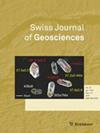Structural and metamorphic evolution of a subducted passive margin: insights from the Briançonnais nappes of the Western Alps (Ubaye–Maira valleys, France–Italy)
IF 2.6
2区 地球科学
Q3 GEOSCIENCES, MULTIDISCIPLINARY
引用次数: 0
Abstract
This contribution analyses the structural architecture and tectono-metamorphic evolution of Briançonnais units in the southern French-Italian Western Alps. The studied area extends from a virtually non-metamorphic area adjacent to the Helvetic-Dauphinois External Domain in the west to the Monviso-Queyras ocean-derived units in the east, where metamorphism increases up to eclogite-facies. Mapping at the scale 1:10.000 of a mountainous part of the Ubaye-Maira transect was performed, which portrays in detail the Briançonnais units over ~ 100 km2. The lithologies include meta-andesite, meta-siliciclastics, marbles, turbiditic calcschists and flysch whose age spans from Late Carboniferous to Eocene. Metamorphism is low-grade greenschist-facies in the west but reaches the blueschist-facies to the east. Structures related to four phases of deformation are identified. The first two generations of structures (D1–D2), related to the original top-to-the-west nappe stacking, are associated with conditions close to the peak of Alpine metamorphism. Previous tectonic surfaces are transposed by the dominant deformation structures (D3), developed under retrograde/decompression conditions. This D3 corresponds to a backfolding and back-thrusting event with a top-to-the-E transport. A fourth phase (D4) developed during late low-grade metamorphic conditions and deforms the previous surfaces by locally developing a crenulation cleavage, followed by brittle tectonics. An updated metamorphic map is presented, backed on published estimates and new thermometric data obtained by Raman Spectroscopy of Carbonaceous Material (RSCM). The TRSCM values range from ~ 295 °C to > 350 °C, moving from the most external Briançonnais unit to the internal Queyras “Schistes Lustrés” units. Suspected Upper Cretaceous palaeofaults have been documented, allowing us to group the classic Aiguille de Mary and Ceillac (sub-) units into a single tectonic unit, here referred to as Maurin unit. The palaeogeographical reconstruction of the evolution of the studied transect highlights the importance of the Marinet and Maurin axial units in the feeding of the Late Cretaceous-Eocene breccias deposited on the more internal Acceglio-type units.俯冲被动边缘的构造与变质演化:来自西阿尔卑斯(法国-意大利Ubaye-Maira山谷)brianonnais推覆构造的启示
本文分析了法国-意大利西阿尔卑斯山脉南部brianonnais单元的构造构造和构造变质演化。研究区从西部与helvet - dauphinois外域相邻的几乎无变质的区域延伸到东部的Monviso-Queyras海源单元,在那里变质作用增加到榴辉岩相。以1:10.000比例尺绘制了Ubaye-Maira样带的山区部分,详细描绘了约100平方公里的brianonnais单元。岩性包括变质安山岩、变质硅屑岩、大理岩、浊积质钙片岩和复理石,年龄跨度为晚石炭世至始新世。变质作用西部为低品位绿片岩相,东部为蓝片岩相。确定了与变形有关的四个阶段的结构。前两代(D1-D2)构造与原始的顶向西推覆堆积有关,与接近高山变质作用高峰的条件有关。以前的构造面被在逆行/减压条件下发育的主导变形构造(D3)置换。这个D3对应于一个反向折叠和反向推力事件,具有从顶部到e的传输。第四阶段(D4)发育于晚期低变质期,通过局部发育砂粒理裂使先前的表面变形,随后是脆性构造。根据已发表的估计和碳质物质拉曼光谱(RSCM)获得的新测温数据,提出了一份更新的变质图。TRSCM值范围从~ 295°C到> 350°C,从最外部的brianis单位移动到内部的Queyras“Schistes lustr”单位。可疑的上白垩纪古断层已被记录,使我们能够将经典的Aiguille de Mary和Ceillac(亚)单元分组为一个构造单元,这里称为莫林单元。对研究样带演化的古地理重建表明,Marinet和Maurin轴向单元对沉积在更内部的acceglio型单元上的晚白垩世-始新世角砾岩的摄食具有重要意义。
本文章由计算机程序翻译,如有差异,请以英文原文为准。
求助全文
约1分钟内获得全文
求助全文
来源期刊

Swiss Journal of Geosciences
地学-地质学
CiteScore
4.50
自引率
12.90%
发文量
21
审稿时长
>12 weeks
期刊介绍:
The Swiss Journal of Geosciences publishes original research and review articles, with a particular focus on the evolution of the Tethys realm and the Alpine/Himalayan orogen. By consolidating the former Eclogae Geologicae Helvetiae and Swiss Bulletin of Mineralogy and Petrology, this international journal covers all disciplines of the solid Earth Sciences, including their practical applications.
The journal gives preference to articles that are of wide interest to the international research community, while at the same time recognising the importance of documenting high-quality geoscientific data in a regional context, including the occasional publication of maps.
 求助内容:
求助内容: 应助结果提醒方式:
应助结果提醒方式:


